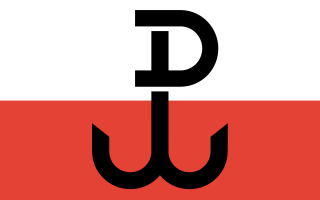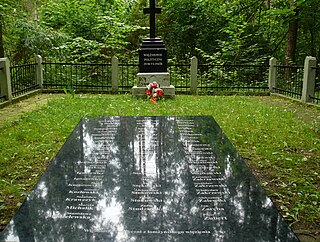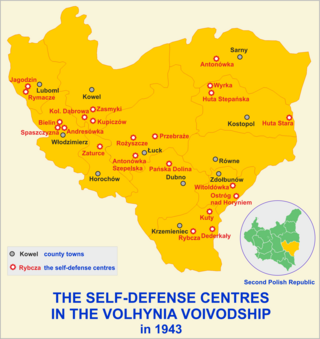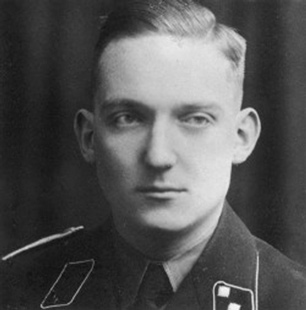
The Home Army was the dominant resistance movement in German-occupied Poland during World War II. The Home Army was formed in February 1942 from the earlier Związek Walki Zbrojnej established in the aftermath of the German and Soviet invasions in September 1939. Over the next two years, the Home Army absorbed most of the other Polish partisans and underground forces. Its allegiance was to the Polish government-in-exile in London, and it constituted the armed wing of what came to be known as the Polish Underground State. Estimates of the Home Army's 1944 strength range between 200,000 and 600,000. The latter number made the Home Army not only Poland's largest underground resistance movement but, along with Soviet and Yugoslav partisans, one of Europe's largest World War II underground movements.

The history of Poland from 1939 to 1945 encompasses primarily the period from the invasion of Poland by Nazi Germany and the Soviet Union to the end of World War II. Following the German–Soviet non-aggression pact, Poland was invaded by Nazi Germany on 1 September 1939 and by the Soviet Union on 17 September. The campaigns ended in early October with Germany and the Soviet Union dividing and annexing the whole of Poland. After the Axis attack on the Soviet Union in the summer of 1941, the entirety of Poland was occupied by Germany, which proceeded to advance its racial and genocidal policies across Poland.

National Armed Forces was a Polish right-wing underground military organization of the National Democracy operating from 1942. During World War II, NSZ troops fought against Nazi Germany and communist partisans. There were also cases of fights with the Home Army.

The Massacres of Poles in Volhynia and Eastern Galicia were carried out in German-occupied Poland by the Ukrainian Insurgent Army (UPA), with the support of parts of the local Ukrainian population, against the Polish minority in Volhynia, Eastern Galicia, parts of Polesia, and the Lublin region from 1943 to 1945.

Operation Tempest or Operation Burza was a series of uprisings conducted during World War II against occupying German forces by the Polish Home Army, the dominant force in the Polish resistance.

The Battle of Wizna was fought between September 7 and September 10, 1939, between the forces of Poland and Germany during the initial stages of the invasion of Poland, which marked the beginning of the Second World War in Europe. According to Polish historian Leszek Moczulski, between 350 and 720 Poles defended a fortified line for three days against more than 40,000 Germans. Although defeat was inevitable, the Polish defence stalled the attacking forces for three days and postponed the encirclement of Independent Operational Group Narew fighting nearby. Eventually the tanks broke through the Polish line and German engineers eliminated all the shelters one by one. The last shelter surrendered around midday on September 10.

The Belarusian resistance during World War II opposed Nazi Germany from 1941 until 1944. Belarus was one of the Soviet republics occupied during Operation Barbarossa. The term Belarusian partisans may refer to Soviet-formed irregular military groups fighting Germany, but has also been used to refer to the disparate independent groups who also fought as guerrillas at the time, including Jewish groups, Polish groups, and nationalist Belarusian forces opposed to Germany.

In Poland, the resistance movement during World War II was led by the Home Army. The Polish resistance is notable among others for disrupting German supply lines to the Eastern Front, and providing intelligence reports to the British intelligence agencies. It was a part of the Polish Underground State.

Poland was invaded and annexed by Nazi Germany and the Soviet Union in the aftermath of the invasion of Poland in 1939. In the pre-war Polish territories annexed by the Soviets the first Soviet partisan groups were formed in 1941, soon after Operation Barbarossa, the German invasion of the Soviet Union. Those groups fought against the Germans, but conflicts with Polish partisans were also common.

Bialystok District was an administrative unit of Nazi Germany created during the World War II invasion of the Soviet Union. It was to the south-east of East Prussia, in present-day northeastern Poland as well as in smaller sections of adjacent present-day Belarus and Lithuania. It was sometimes also referred to by the designation South East Prussia along with the Regierungsbezirk Zichenau, although in contrast to the latter, it was not incorporated into, but merely attached to East Prussia.

Jeziorko is a village in the administrative district of Gmina Piątnica, within Łomża County, Podlaskie Voivodeship, in north-eastern Poland. It lies approximately 6 kilometres (4 mi) north-east of Piątnica, 8 km (5 mi) north-east of Łomża, and 68 km (42 mi) west of the regional capital Białystok.

Stanisław Karolkiewicz (1918–2009) was born in 1918 in the Polish historical region of Podlasie. Raised in a patriotic family, he joined the Polish Army in the 1930s, and then fought in the Polish September Campaign, in the area of Upper Silesia. On 17 September 1939, when the Red Army, allied with the Wehrmacht, attacked eastern Poland, Karolkiewicz was around Nisko.

Striking Cadre Battalions were armed anti-Nazi resistance units organized by the right-wing Polish resistance organization Confederation of the Nation. They existed between late 1942 and early 1944.

Turośl is a village in the administrative district of Gmina Pisz, within Pisz County, Warmian-Masurian Voivodeship, in north-eastern Poland. It lies approximately 18 kilometres (11 mi) south-west of Pisz and 79 km (49 mi) east of the regional capital Olsztyn. It is located in the region of Masuria.

The Brześć Ghetto or the Ghetto in Brest on the Bug, also: Brześć nad Bugiem Ghetto, and Brest-Litovsk Ghetto was a Nazi ghetto created in occupied Western Belarus in December 1941, six months after the German troops had invaded the Soviet Union in June 1941. Less than a year after the creation of the ghetto, around October 15–18, 1942, most of approximately 20,000 Jewish inhabitants of Brest (Brześć) were murdered; over 5,000 were executed locally at the Brest Fortress on the orders of Karl Eberhard Schöngarth; the rest in the secluded forest of the Bronna Góra extermination site, sent there aboard Holocaust trains under the guise of 'resettlement'.

Kuty (Kąty) defence was a skirmish between Polish self-defense units and Ukrainian Insurgent Army unit under commander Ivan Klymshyn and Andriy Melnyk's supporters in the village of Kuty located in Volhynia, Krzemieniec (Kremenets) county, Shumsk commune 3 or 4 May 1943. During the fight no less than 53 Poles were killed, although the assault was repelled by self-defense forces. After the battle Poles abandoned the village, and escorted by Germans went to Shumsk and later to Kremenets.
Operation Heads was the code name for a series of assassinations of Nazi officials by the World War II Polish Resistance. Those targeted for assassination had been sentenced to death by Polish Underground Special Courts for crimes against Polish citizens during the World War II German occupation of Poland. The operation's code name, literally "Operation Little Heads", was a sardonic reference to the Totenkopf insignia on Nazi German SS uniforms and headgear.

Hermann Schaper, was a German SS functionary during the Nazi era. He was a Holocaust perpetrator responsible for atrocities committed by the Einsatzgruppen in German-occupied Poland and the Soviet Union and was convicted after the war of numerous war crimes.
The Koniuchy massacre or the Kaniūkai massacre was a World War II massacre of civilians, mostly women and children, carried out in the village of Koniuchy on 29 January 1944 by a Soviet partisan unit together with a contingent of Jewish partisans under Soviet command. At least 38 civilians who have been identified by name were killed, and more than a dozen were injured. In addition, houses were burned and livestock was slaughtered. It was the largest atrocity committed by the Soviet partisans in present-day Lithuania.

The Krasowo-Częstki massacre was a Nazi war crime perpetrated by the Ordnungspolizei and SS in the village of Krasowo-Częstki within occupied Poland. On 17 July 1943, the village was completely burned; 257 of its inhabitants, mostly women and children, were murdered. The massacre was an act of retaliation against the civilian population, after at least eight Germans were killed in a skirmish with Polish partisans in the nearby colony of Kalnik. It was the bloodiest pacification action conducted by Nazi-German occupiers in those areas of prewar Białystok Voivodeship, which after Second World War remain within the borders of Poland.
















